Spring processing of honeysuckle from pests and diseases
Honeysuckle is a plant that is easy to care for. It takes root in the northern and southern regions of the country. Honeysuckle berries are rich in vitamin C and are eaten fresh or used for processing.
To get a rich harvest, it is not enough to water and fertilize the shrub on time, it is important to carry out preventive and protective measures against diseases and pests. A novice gardener may be faced with a number of questions: how to spray the bushes, what drugs are the most effective, how to recognize diseases.
In this article you will find answers to these and other popular questions about the processing of honeysuckle.
The content of the article
How to process honeysuckle in the spring from the most dangerous diseases and pests during this period
In the spring, pests wake up after hibernation. They hibernate in soil, plant debris, last year's foliage. If you don't spray your shrubs, you can lose your entire crop.
Honeysuckle pests and protection against them
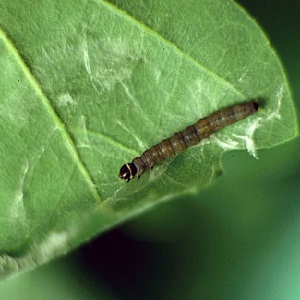
Spring treatment of honeysuckle against pests and diseases is an important stage in plant care. Insects become active in warm weather - while not only adults, but also larvae are dangerous for honeysuckle.
Many pests are difficult to spot - their size does not exceed 3 mm. Therefore, gardeners and gardeners recommend regularly examining the honeysuckle leaves from all sides.
Honeysuckle moth
The moth is a large gray butterfly. Adults live on fruit and berry bushes. But for honeysuckle, the caterpillar of the honeysuckle moth poses a threat - it eats the leaves. Caterpillars are especially active on young bushes. The cause of infection is diseased seedlings, soil with pest larvae.
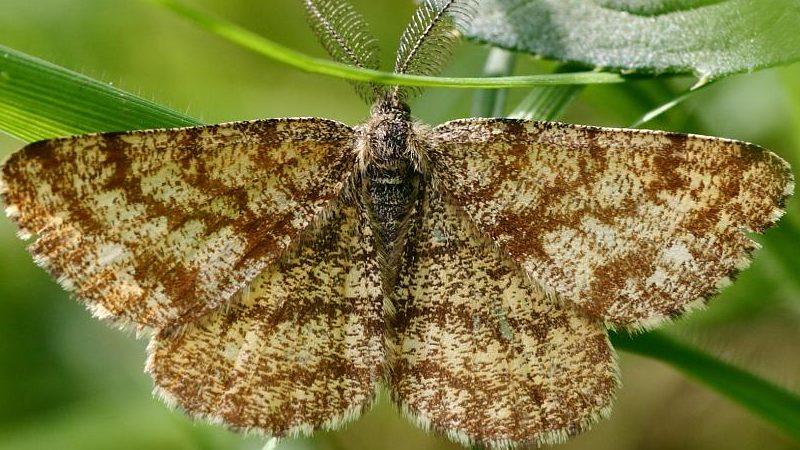
Spraying with Actellik helps to prevent the appearance of the honeysuckle moth. The solution is prepared on the day of use - 1 ampoule (2 ml) is required for 2 liters of water. Honeysuckle leaves are evenly moistened. The procedure is carried out in dry and calm weather. The drug is not dangerous for humans and animals, it is compatible with most biological products, with the exception of Bordeaux liquid.
Honeysuckle mite
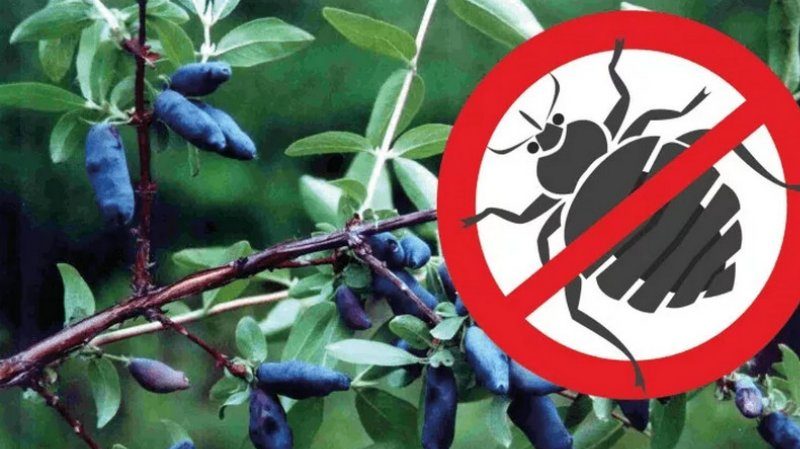
Ticks are actively developing in conditions of thickened plantings, so it is important to timely prune the shrub and keep the distance between the plants. Also favorable conditions for the development of the pest are wet and cloudy weather. Signs of mite damage - dark shapeless spots appear on the underside of the leaves, after 2-3 weeks the leaf plates turn brown and curl. If not processed in time landingthen the leaves fall off.
For prevention and protection, it is recommended to use the drug "Omite". It destroys larvae, nymphs and adults. The product is diluted with water and sprayed with the plant in dry weather. To prepare the working fluid, use only clean water. The most effective "Omite" at temperatures above + 20 ° C.
Attention! Correct spring feeding will help to strengthen the plant's immunity and protect it from pests. Summer residents are advised to prepare a nutritional composition in early April: 1 tbsp is required for 10 liters of water. l. nitrophoska and 1 tbsp. l. fertilizers "Berry". A honeysuckle bush requires 3 to 8 liters of solution, depending on the age of the plant. The older the honeysuckle, the more fertilizer is used.
Honeysuckle aphid
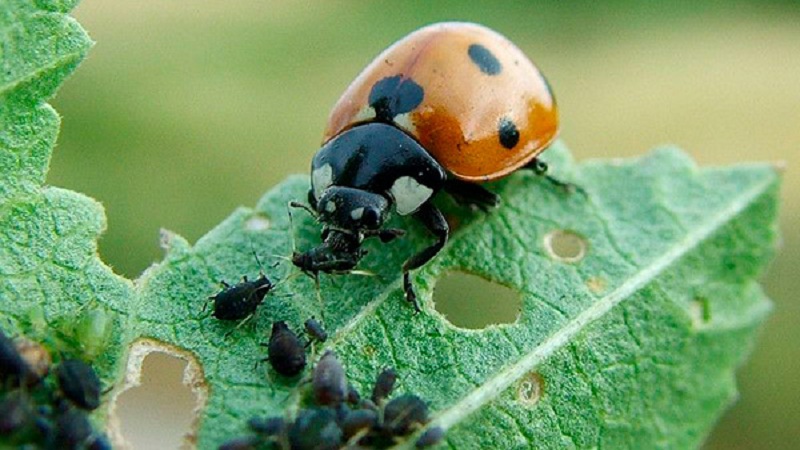
Honeysuckle aphid prefers young green shoots. Leaves turn yellow and stained, later curl and become thinner. Due to aphids, shoots stop growing, which leads to a decrease in yield.
Most often, aphids appear on thickened plantings. Weeds contribute to the development of the pest, therefore it is recommended to regularly remove them and monitor for the purity of the soil. For processing, an infusion of garlic is used - 5 heads of peeled garlic and 1 kg of dandelions are soaked in a bucket. The solution is left for a day in a warm place, filtered and treated with the affected plants.
If the aphid has already appeared on the honeysuckle, it is recommended to use the drug "Aktara". It is used in two ways - by spraying and root application. For 5 liters of water, 1 g of the drug is required. Aktara has a systemic effect and prevents the emergence of new pests.
Acacia false shield
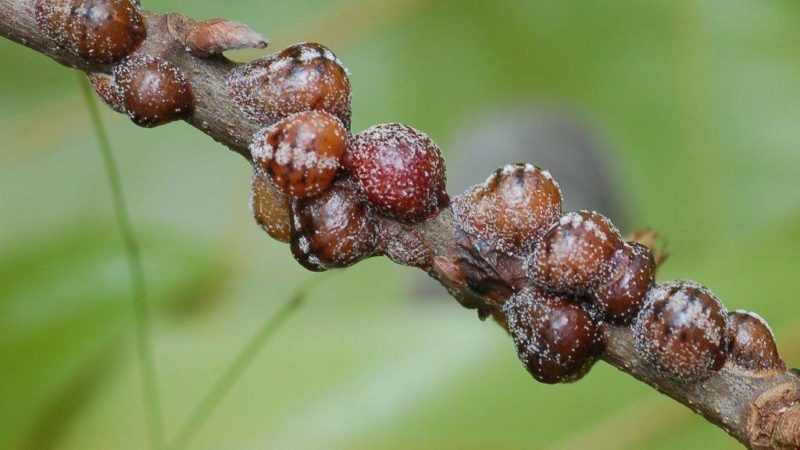
The acacia scale damages most fruit and berry crops. The larvae overwinter on old branches of the affected plants. Insects appear on honeysuckle in May, when the air temperature warms up to + 10 ° C. The false shield sticks to the shoots and sucks out the cell sap from them. Because of this, the leaves turn brown and fall off, the shoots dry out completely.
To prevent the appearance of acacia false shield, summer residents use spraying with a 2% solution of "Fufanon". For 10 liters of water, 200 g is required. To get rid of pests, take "Kemifos" - 10 ml of water is required for 10 liters of water. In case of severe damage, summer residents remove the plants and burn them.
Leaf rollers
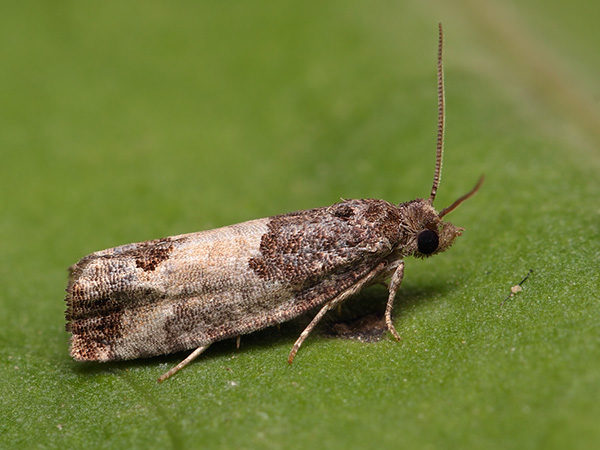
Leaf rollers are gray-brown winged insects. Outwardly, the pest looks like a large aphid. A sign of the appearance of a pest on honeysuckle - the leaves are twisted into a longitudinal tube. On shrubs, honeysuckle appears mainly in late May - early June.
If found, it is recommended to cut off the affected shoots and burn them or process the bushes after flowering with Fitoverm. For 2 liters of water, 1 ampoule is required. The tool is effective even in hot and rainy weather, no more than 1.5 liters of solution are used for 1 bush. For preventive purposes, honeysuckle is sprayed with a solution of Bordeaux liquid.
Honeysuckle diseases and protection against them
Honeysuckle diseases appear due to weak immunity, infested soil, weeds, hot and humid weather. Sometimes the cause of infection lies in plant debris or diseased in the neighborhood of plants.
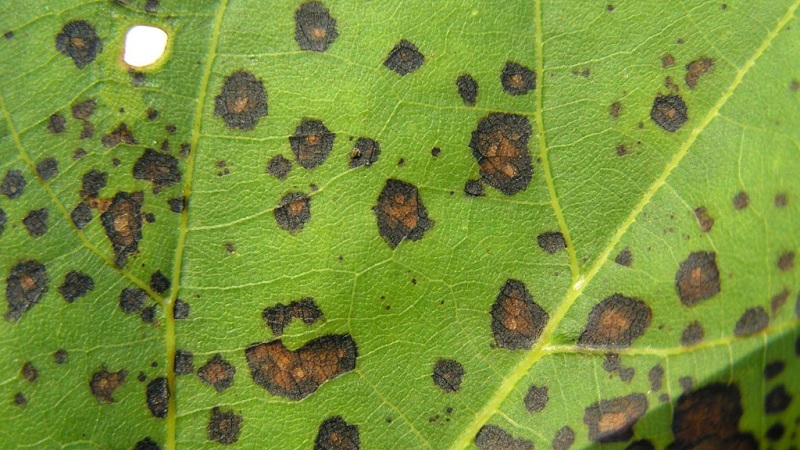
Cercosporosis
A common disease in all horticultural and horticultural crops. Small spots with reddish-brown edges appear on the leaves. They grow over time and cover the entire leaf, the plate dries out. Cercosporiasis affects the leaves, but in hot weather and high humidity, symptoms appear on the petioles and stems.
In early spring, summer residents spray the honeysuckle with a 2% solution of Fundazol. It works effectively in all climatic zones and is harmless to humans and animals.
In order to prevent the appearance of cercosporosis, treatment with a copper-soap solution is used. Cooking requires 10 liters of water, 100 g of copper sulfate and 50 g of liquid soap. Spray the honeysuckle in the morning or evening in dry weather.
Powdery mildew
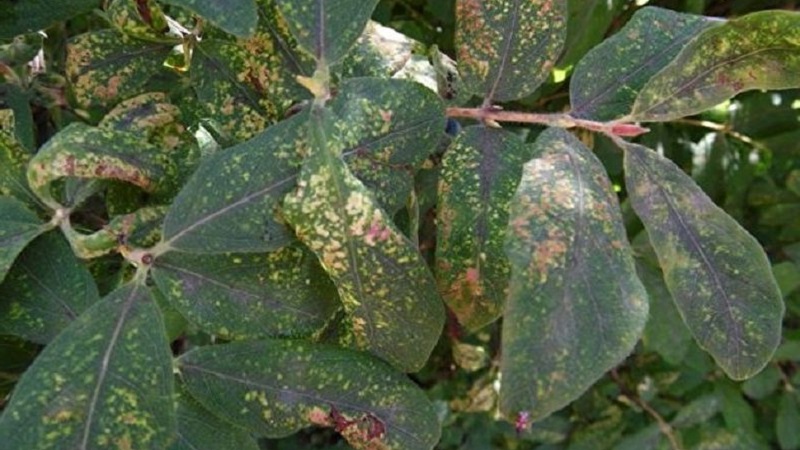
Powdery mildew appears in late spring or early summer when the weather is warm. It is easy to recognize the disease - leaves and shoots are covered with a white bloom. The fungus spreads especially quickly in rainy weather. If measures are not taken in time, then the shoots dry out and become covered with large brown spots. All this has a bad effect on the yield and immunity of the plant.
Timely pruning of shoots helps to prevent the appearance of powdery mildew. For the treatment of summer residents use the drug "Vectra". For 1 liter of water, 0.3 ml is required. The effect of the drug lasts for 2 weeks. In total, honeysuckle can be treated with a solution 2-3 times per season.
Attention! The drug "Discor" helps against powdery mildew and cercospora.It is available in ampoules or vials and has a faint odor. "Discor" penetrates into plant tissues, is non-phytotoxic. Honeysuckle is sprayed during the growing season.
Tuberculariosis
Like any fungal disease, tuberculariosis develops especially actively in warm weather. On the affected shoots, brownish-brown spots and tubercles appear, which quickly spread to the shoots growing nearby. Soon the branches dry out completely, the shrub dies, the summer residents have no choice but to burn it.
For preventive purposes, honeysuckle is sprayed with a solution of Bordeaux liquid. For treatment, the drug "Mikosan" is used. It is recommended to use it at the initial stage, when signs of infection are just beginning to appear on the shoots. Consumption rates - 100 ml per 2 liters of water.
Ramulariasis
Fungal disease primarily affects old leaves. Brown-red spots form along the edges, which over time increase in size and become covered with a white coating. Spores of ramulariasis hibernate on plant debris or in the soil; in spring they wake up and are carried around the garden by wind and rain. The disease is especially active when the temperature rises to + 15 ° C. Signs of ramulariasis appear on the roots with stems. The metabolism of honeysuckle is disrupted, the root system weakens, the shoots dry out.
Timely watering and removing weeds helps prevent disease. Also, summer residents recommend maintaining the density of plantings and loosen the soil once every 2 weeks. For the treatment of affected shrubs use "Fitosporin" - 10 liters of water requires 5 g of the drug.
Rust
Rust is dangerous in that it causes the death of leaves, and if it spreads, the entire shrub. The frost resistance of honeysuckle decreases, it becomes weak, and the yield decreases. The shrub loses moisture, metabolism is disturbed. Signs of infection are orange swollen spots on the surface of the leaf plate.
For preventive purposes, gardeners use spraying with soapy water - 100 g of grated laundry soap is required for 5 liters of water. For treatment use the drug "Cumulus".

How to handle honeysuckle after harvest
After harvesting, the honeysuckle is prepared for winter - the shrub is pruned, the plant is sprayed. Such agrotechnical measures help to avoid the appearance diseases and pests next year.
Pruning honeysuckle
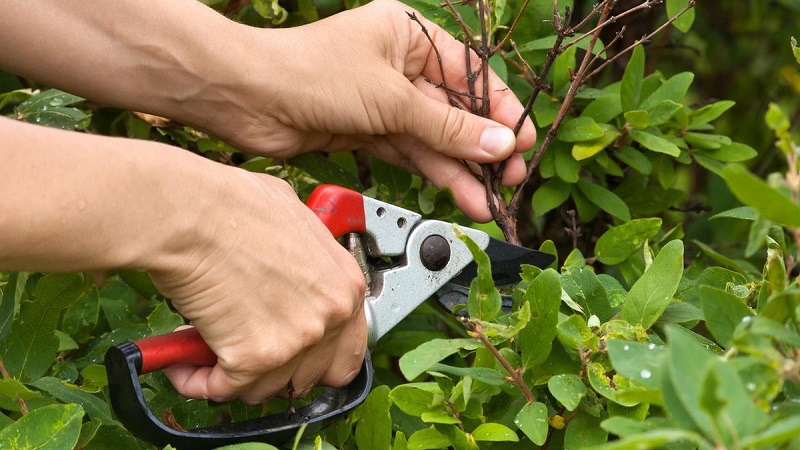
Winter preparations begin in early August... A few weeks before this, reduce the number of waterings. This is done in order to slow down the growth of the plant and not awaken new buds.
In the period from August 20 to September 10, pruning is carried out - the root shoots and branches that grow inside the bush are removed. The top of the plant should not be wider than its root zone. Otherwise, the shrubbery may break due to strong winds. The crown should taper towards the top.
Use a handy garden pruner for pruning. To avoid parasites and mold, the cut is made even. Summer residents grease it with paint or clay to protect it from diseases and pests. After pruning, the honeysuckle is watered abundantly for several days - moisture restores the plant.
How to spray
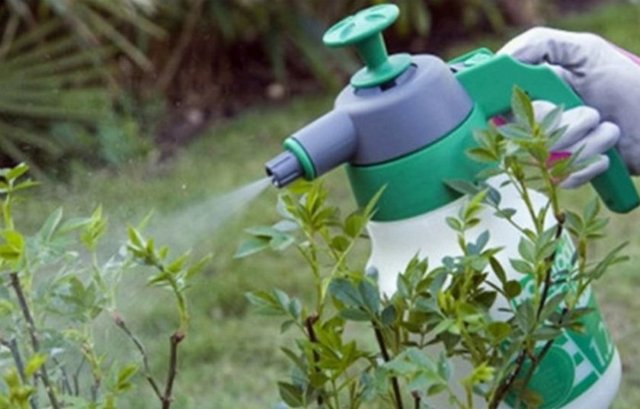
Processing prepares the plant for winter, protects against insects and pests. Foliar dressing strengthen the immune system and provide a bountiful harvest.
How to spray honeysuckle from pests and diseases in the fall:
- urea solution - 700 g of substance is required per 10 liters of water;
- a solution based on tobacco and pepper - 5 liters of hot water, 500 g of tobacco and 300 g of ground pepper;
- iodine solution - add 10 drops of iodine to 10 liters of water;
- the preparation "Rogor-S" - protects against sucking insects, lasts for 21 days.
Conclusion
In early spring, summer residents begin to process honeysuckle. To protect against pests, use drugs "Aktellik", "Omayt", "Aktara", against diseases - Bordeaux liquid, "Mikosan", "Vectra".From folk remedies, it is recommended to use a garlic soap solution or an iodine-based solution.
When processing, it is important to observe the recommended dosages and safety rules - when spraying, use gloves and a respirator. The optimal time for processing is morning or evening. Carrying out preventive measures increases fruiting and strengthens the immunity of honeysuckle.